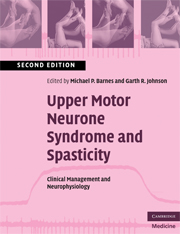Book contents
- Frontmatter
- Contents
- List of Contributors
- Preface to the second edition
- 1 An overview of the clinical management of spasticity
- 2 Neurophysiology of spasticity
- 3 The measurement of spasticity
- 4 Physiotherapy management of spasticity
- 5 Seating and positioning
- 6 Orthoses, splints and casts
- 7 Pharmacological management of spasticity
- 8 Chemical neurolysis in the management of muscle spasticity
- 9 Spasticity and botulinum toxin
- 10 Intrathecal baclofen for the control of spinal and supraspinal spasticity
- 11 Surgical management of spasticity
- 12 Management of spasticity in children
- Index
- References
10 - Intrathecal baclofen for the control of spinal and supraspinal spasticity
Published online by Cambridge University Press: 22 August 2009
- Frontmatter
- Contents
- List of Contributors
- Preface to the second edition
- 1 An overview of the clinical management of spasticity
- 2 Neurophysiology of spasticity
- 3 The measurement of spasticity
- 4 Physiotherapy management of spasticity
- 5 Seating and positioning
- 6 Orthoses, splints and casts
- 7 Pharmacological management of spasticity
- 8 Chemical neurolysis in the management of muscle spasticity
- 9 Spasticity and botulinum toxin
- 10 Intrathecal baclofen for the control of spinal and supraspinal spasticity
- 11 Surgical management of spasticity
- 12 Management of spasticity in children
- Index
- References
Summary
Introduction
Intrathecal baclofen (ITB)
Penn and Kroin (1985) first described the benefits that could be obtained by long-term infusion of baclofen into the spinal subarachnoid space, reporting the treatment of six patients with severe continuing spasticity and spasms resulting from spinal injury or multiple sclerosis. They found a dramatic dose-related benefit which was highly valued by patients. Patients reported functional improvements in their activities of daily living (ADLs), reduced discomfort, improvement in sleep patterns, continence and nocturia. Voluntary power did not necessarily improve, but one patient in the initial series was enabled to walk provided that the dose was carefully titrated. Control of her spasticity and spasms was needed, but some lower limb tone had to be retained.
Penn and Kroin found that the optimum dose varied widely and that the effects were strongly dose-related. There was some evidence of drug tolerance: during the first few months, the average daily dose rose from 100 to 150 μg to something approaching 500 μg. Because they were so much improved, patients were unwilling to take part in controlled trials involving placebo infusions.
All of the significant findings put forward in this initial report have been amply confirmed during the following years, in subsequent larger and longer trials undertaken by the same authors and in many other centres. The initial and many subsequent trials were open; but double-blind, randomized, placebo-controlled trials of ITB have more recently been conducted in spinal spasticity and have reported a similar magnitude of benefit (Ordia et al., 1996).
Keywords
- Type
- Chapter
- Information
- Upper Motor Neurone Syndrome and SpasticityClinical Management and Neurophysiology, pp. 181 - 192Publisher: Cambridge University PressPrint publication year: 2008
References
- 1
- Cited by

